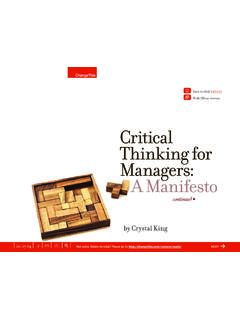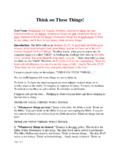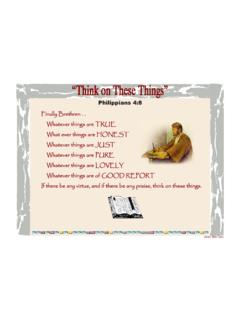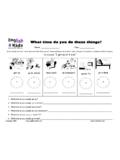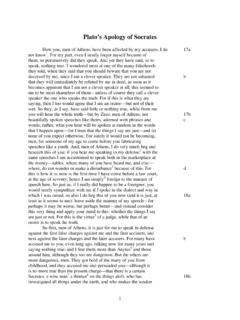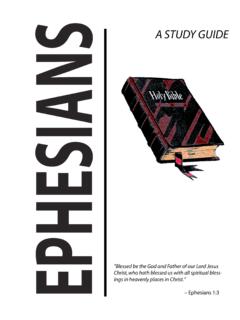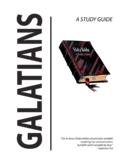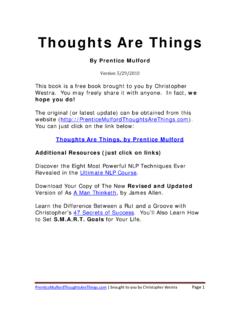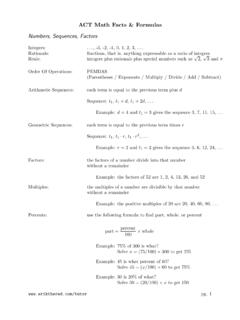Transcription of Nine Things I Learned from Alan Mulally - changethis.com
1 | ChangeThisNine Things I Learned from Alan MulallyBryce G. Hoffman | ChangeThisIn the summer of 2010, I decided to take a year off from my job as a journalist with The Detroit News to write a book about one of the most amazing comebacks in business history: the turnaround of Ford Motor Company. As the Ford beat reporter for the News, I had covered every twist and turn of that epic drama. I knew that this story was about much more than saving a car company. It was a roadmap for changing Alan Mulally arrived in Dearborn in September 2006, he knew little about the automobile industry. However, he had already figured out how to take a dysfunctional organization that was being ripped apart by managerial infighting and turn it into a model of collaboration and effi-ciency.
2 Mulally had proven that at the Boeing Company, where he was credited with saving the commercial aircraft division from a series of catastrophes ranging from the Asian financial crisis of the late 1990s to the terrorist attacks of September 11, 2001, that had cost Boeing most of its business. But Mulally s biggest accomplishment in Seattle was saving Boeing from itself. Now Bill Ford Jr. was asking him to do the same thing with was a daunting task. Ford the company that put the world on wheels was on the verge of bankruptcy. For decades, it had been fighting a losing battle against foreign automakers that not only made better cars, but also did so more efficiently and at substantially lower cost.
3 | ChangeThisWhile Toyota Motor Corporation and Honda Motor Company were booking record profits, Ford was about to announce a $ billion loss the biggest in its century-long history. Yet Ford s most serious competition was inside the company automaker s global divisions had become warring factions as executives fought for supremacy in what had become one of the most cutthroat, careerist cultures in the business world. Executives made decisions not on the basis of what was best for the customer or even Ford s bottom line, but by what would make them look good and their rivals look bad. This attitude extended right down to the factory floor, where union bosses jealously guarded the high wages and gold-plated benefits they had won for their members in better Mulally arrived in Dearborn like a Kansas cyclone, ripping through Ford s dark-paneled corridors like a twister through a trailer park.
4 He would take a sledgehammer to the automaker s ossified silos, force long-time adversaries to kiss and make-up and challenge Ford s most cherished delusions. Over the next three years, he would also make Ford the most profitable automaker in the world. Mulally would do it as the rest of the American automobile industry fell apart in the face of the worst economic crisis since the Great Depression. And he would do it without taking a government bailout. | ChangeThisI chronicle those events in my new book, American Icon: Alan Mulally and the Fight to Save Ford Motor Company. During the year I spent researching and writing this book, I spent many hours sitting across the table from Mulally in his corner office on the twelfth floor of Ford s world headquarters.
5 I Learned a lot about how to change cultures and streamline organizations, and I believe these principles will prove as valuable to your organization as they have to | HAVE A CLEAR, COMPELLING VISION THAT INFORMS EVERYTHING YOU have to know what you are and what you are trying to achieve. Before Alan Mulally was hired, Ford had lost its way. Instead of acting, it was reacting. It was making cars that nobody wanted to buy because union contracts prohibited layoffs. Its vehicles were boring because bean-counters undermined the work of designers and knew that every organization needs a clear and compelling vision. At Boeing, it was all about shrinking the world and bringing cultures together through jet transportation.
6 When Mulally arrived in Dearborn, one of his first priorities was identifying Ford s value proposition. He found it in the company s archives, in an old Saturday Evening Post ad from 1925 in which Henry Ford outlined his own vision for the company: Opening the highways for all mankind. | ChangeThisMulally had that ad blown up and mounted on his wall. He passed out copies to each of Ford s top executives. And he made sure that all future product decisions would be weighed against that promise. It might sound hokey, but he was dead serious and it made a real difference on where Ford focused its R&D of concentrating on hybrids and battery powered motors, Ford s first priority became the EcoBoost engine.
7 This game-changing motor combined turbo-charging and direct fuel-injection to give V-6 engines the power of a big, gas-guzzling V-8 and sippy four-bangers the power of a V-6. Why? Because it was cheaper and meant far more customers could enjoy the benefits of fuel-saving technology. EcoBoost technology would only add a few hundred bucks to the price of a car or truck, while a hybrid powertrain would add thousands of dollars to the sticker price. Ford did the math and figured out that it would only take a couple of years for the average customer to recoup that added cost, compared to nearly a decade for a have to know what you are and what you are trying to achieve. | ChangeThisFord s decision to bet big on EcoBoost was all about democratizing fuel-saving technology a twenty-first century realization of Opening the highways for all mankind.
8 Find your organization s pole star and let it guide all of your | HAVE A PLAN, KEEP IT SIMPLE AND STICK TO ITThis might seem obvious, but this was downright revolutionary at Ford. Sure, the automaker had plans. In fact, it was infamous for rolling out a new one every six months or so. They all had catchy names: Back to Basics, The Way Forward and The Way Forward Acceleration. Mulally didn t care what his plan was called. He was more interested in making sure that it was simple, straightforward and religiously adhered to by the entire he had dissected Ford s financials, diagnosed its disease and formulated a cure, Mulally reduced his entire turnaround strategy to four simple, easy-to-understand points: Aggressively restructure to operate profitably at the current demand and changing model mix Accelerate development of new products our customers want and value Finance our plan and improve our balance sheet Work together effectively as one team | ChangeThisMulally had these four bullet points printed on wallet cards and distributed to every Ford employee.
9 He opened every weekly meeting by reviewing them. He recited them in every speech, in ever town hall meeting, in every press conference. After six months, those of us who followed the company had gotten sick of hearing about them. During a one-on-one interview after the New York auto show in the spring of 2007, I actually confronted Mulally about this. I told him the Wall Street analysts I talked to were growing impa-tient. I told him they were tired of hearing about these same four points. But, Bryce, we re still working on this plan, he replied incredulously. Until we achieve these goals, why would we need another one? Even in the depths of the economic crisis that did in Ford s cross-town rivals, Mulally steadfastly refused to budge from this plan.
10 His CFO insisted on cutting spending on new products to preserve what was left of Ford s cash reserves. Mulally said no. Find your organization s pole star and let it guide all of your decisions. | ChangeThisThere was no point in preserving cash if the company had no future, and without better cars and trucks, it had none. That did not mean that near-term targets were not tweaked to account for the changing business realities, but it did mean the overarching goals of the plan remained many organizations try to change course when the going gets tough. But as Henry Ford once said, It is failure that is easy. Success is always hard. So resist the temptation to scrap your plan at the first sign of trouble.




